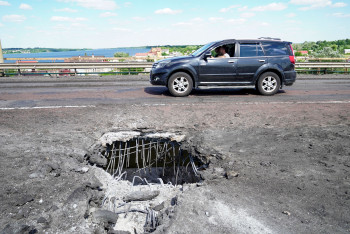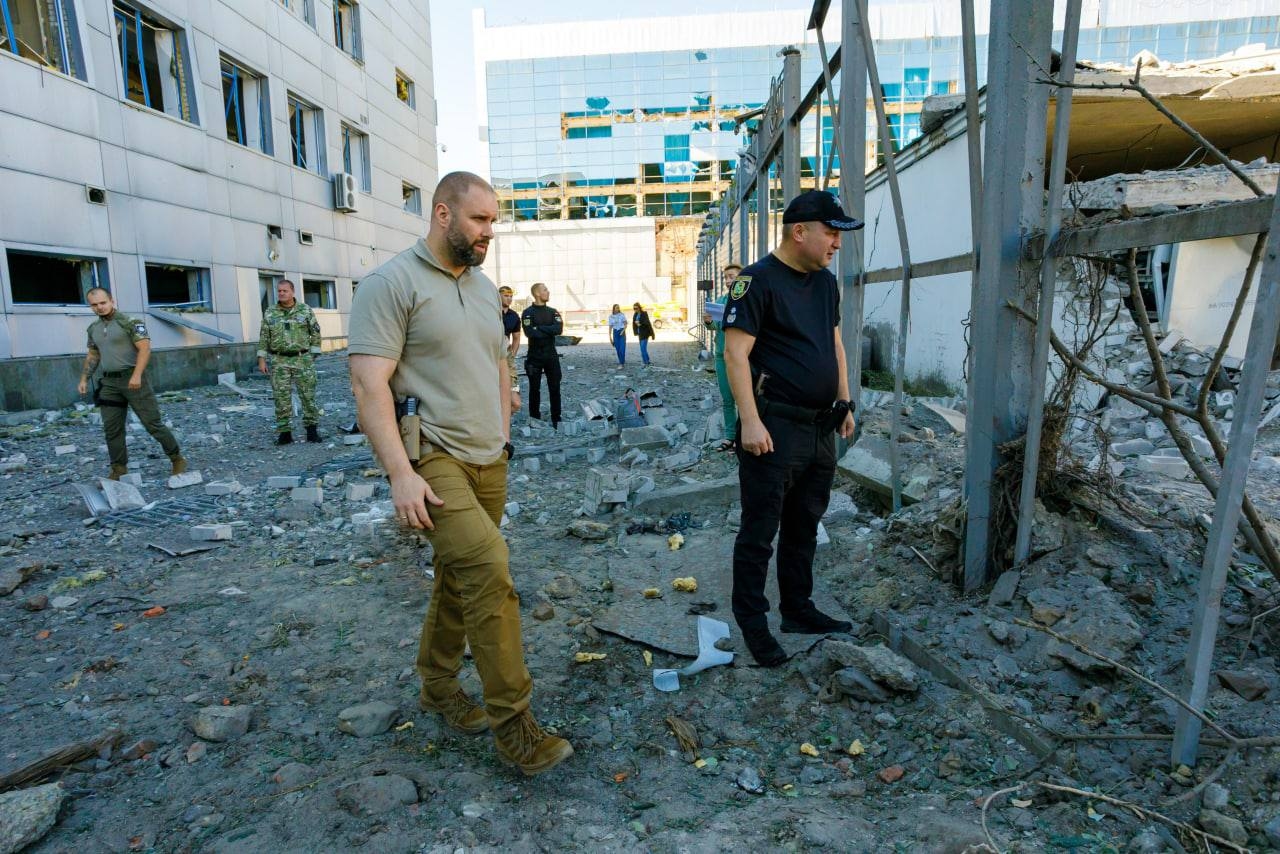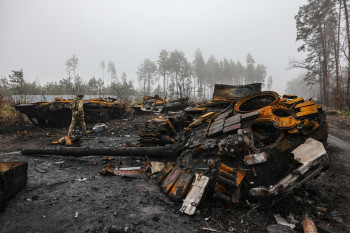Ukraine war latest: IAEA inspectors continue mission at Zaporizhzhia plant as Russia cuts off gas supply to Europe

As an International Atomic Energy Agency (IAEA) team carried out a mission to inspect the Zaporizhzhia nuclear power plant, Ukraine’s major counteroffensive continued in the south.
Tensions remained high around the Moscow-controlled Zaporizhzhia nuclear plant while the inspectors continued to assess the safety and security of the damaged facility, as well as speak to the staff.
Speaking at a briefing in Vienna following his initial visit to Ukraine’s plant, IAEA chief Rafael Grossi said that two of his “experienced” staff members will permanently remain on the territory of the plant. Grossi said the inspectors' safety will come first and the agency will be communicating with the remaining staff regularly.
Without naming who is behind the shellings, Grossi said that the “physical integrity (of the plant) is more compromised” due to what he described as a recent trend of shelling around the plant that began in August.
Meanwhile, several regions came under fire as Russian forces launched missile strikes and renewed shelling on residential areas while intense fighting continued in the east and south.
In the east, Russia is regrouping its military in an effort to increase the number of troops near Donetsk and possibly resume offensive operations, according to Deputy Chief of the Ukrainian Main Operational Department Oleksiy Gromov, the Institute for the Study of War, a D.C.-based think tank, reported.
Across Europe, geopolitical tensions heightened as Russia’s gas monopoly Gazprom announced an indefinite shutdown of the Nord Stream 1 pipeline amid a deepening energy crisis. Citing a gas leak, the state-owned company provided no time frame for when the gas would start flowing again, saying it won’t resume supplying gas to Europe until repairs were fully implemented.
Gazprom’s announcement comes as the G7 countries agreed to introduce a price cap on Russian oil starting Dec. 5 in a move aimed at reducing Moscow’s overall revenues that contribute to its war efforts in Ukraine.
There may be a connection between the G7’s decision regarding the price cap on Russian oil and Gazprom’s announcement, Olena Pavlenko, President of the Dixie Group, a Kyiv-based think-tank focused on energy issues, said.
Even if there is an issue with the supply, it seems artificial that Nord Stream 1 is suddenly having so many problems even though it has been operating since 2011, according to Pavlenko.
Earlier in July, the pipeline was shut down for 10 days for repairs, after Russia claimed Western sanctions were to blame for Nord Stream 1’s needed maintenance.
“I think this is part of its blackmail strategy,” Pavlenko told the Kyiv Independent.
If Russia was really keen on sending gas to Europe, it could do so by using Ukrainian pipelines which "still have a lot of free capacity," Oleksandr Kharchenko, managing director of the Energy Industry Research Center, a research and consulting firm in Kyiv, said.
Gazprom’s latest move may be Russia’s attempt to push the EU to soften its sanctions or change its policy against Russia, Kharchenko told the Kyiv Independent.
Risky mission
IAEA chief Grossi said that he was worried about the situation at the Zaporizhzhia nuclear power plant after a few hours-long inspection.
While Ukraine’s state nuclear operator Energoatom said that one of the two operating reactors that was temporarily disconnected from the power grid due to Russian shelling had been turned back on, concerns over the nuclear safety of the plant are heightening over a possible disaster.
Ukraine has accused Russia of holding the plant hostage, storing weapons there while carrying out attacks on nearby residential areas from the facility. In a bid to avoid a confrontation, Russian forces may have relocated their military equipment stored at the site elsewhere and moved about 100 units of unspecified hardware to another plant, Ukraine’s General Staff said on Sept. 2.
Russian Defense Minister Sergei Shoigu, who blamed Ukrainian forces for continuing their shelling of the plant in the morning and thus raising the risk of a disaster, claimed that there was no military equipment at the nuclear site.
Satellite images released by the U.K. Defense Ministry dated Aug. 21 show that Russia had military equipment within 60 meters of one of the plant's reactors.
Ukrainian officials believe Russian forces will try to conceal evidence of their military activity from the plant and alleged abuses of the remaining Ukrainian staff on site. Energoatom said the IAEA mission wasn’t allowed to go inside the Zaporizhzhia plant’s crisis center where Russian troops are reportedly stationed.
In an evening briefing, Ukraine’s General Staff reported that “precise strikes” by Ukraine’s military had destroyed Russian artillery systems, as well as ammunition depots in both Kherson and the town of Enerhodar, where the Zaporizhzhia power plant is located.
Raging battlefields
As new developments revolved around the occupied nuclear plant, heavy fighting centered in Donetsk and Kherson oblasts continued.
Explosions were repeatedly heard in the occupied city of Kherson throughout Sept. 2, Suspilne television reported.
While Ukraine’s military has given no details regarding its territorial gains or losses in the south, Russian forces appear to be reacting to the ongoing counteroffensive in Kherson Oblast by consistently reinforcing the region with military convoys transported through the Kerch Strait Bridge, regional news website Krim.Realii’s footage shows.
Ukraine’s Operational Command “South” reported that in Ukraine’s south, Ukrainian forces killed 37 Russian troops and destroyed three tanks, four Msta-B howitzers, a Grad multiple rocket launcher, 10 armored vehicles, and an ammunition depot.
The ISW repored on Sept. 2 that Russian military bloggers have repeatedly claimed that Ukraine’s southern counteroffensive has already failed, but the think tank also noted that “military operations on the scale of the ongoing Ukrainian counteroffensive do not succeed or fail in a day or a week” and that observers “should not fall for” Russian propaganda regarding the counteroffensive.
To the east, the Russian offensive toward several Donetsk Oblast cities including Soledar and Bakhmut were repelled, according to Ukraine’s General Staff.
Ukraine and the West’s intelligence assessments of the Russian military continue to report that Russian soldiers are inexperienced.
Ukraine’s Intelligence suggested that Russia has been experiencing troop shortage since the start of the full-scale war, only being able to send around 300,000 to 350,000 soldiers since many units are busy guarding Kremlin facilities within the country and abroad.
A U.K. intelligence update on Sept. 2 said Russia’s war performance in Ukraine shows that its regularly-held strategic drills have failed to yield results.
Indiscriminate civilian attacks
In Donetsk Oblast, where the government has imposed a mandatory evacuation of the remaining residents to save them from Russia’s incessant attacks on civilian infrastructure, another four people were killed and 10 others were injured on Sept. 1, its governor Pavlo Kyrylenko reported.
Kharkiv, Ukraine’s second-largest city, was also hit with Russia’s S-300 anti-aircraft missiles overnight, damaging a premise of a well-known sports complex and other civilian sites, including vehicles, Kharkiv Oblast Governor Oleh Synyehubov said.
Russian forces also shelled northern Sumy and Chernihiv oblasts overnight using mortars and rocket artillery, according to the State Border Guard Service. With dozens of explosions reported in each oblast, civilian infrastructure, including residential buildings, was reportedly damaged.
As the full-scale war enters its seventh month, more than 7,000 civilians have been killed and at least 5,000 injured, First Deputy Interior Minister Yevhen Yenin said on Sept. 2. According to the official, 90 percent of the 24,000 facilities hit by Russia since the full-scale invasion began were civilian infrastructure.
These figures are expected to be much higher, as Ukraine cannot access occupied territories or where there is heavy fighting to calculate death tolls.















